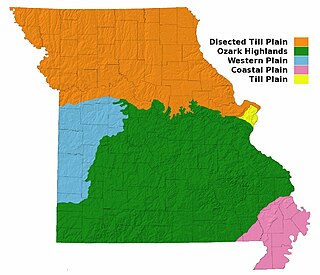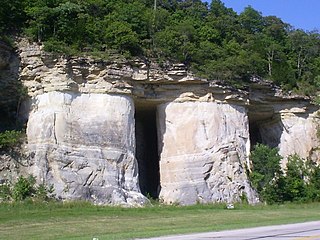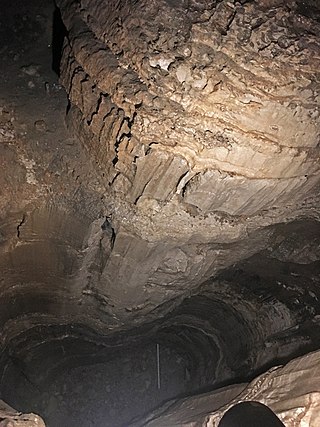St. Genevieve marble, also known as Ste. Genevieve marble, is an oolitic limestone (or "marble") found in Sainte Genevieve County, Missouri. [1] It is part of the Archimedes Limestone formation. [2]
It generally comes in two different types. "St. Genevieve Rose" is the name for the marble which comes in deep red, greenish-gray, pink, and rose. [3] "St. Genevieve Gold Vein" is light or medium gray in color, with veins (running from buff to tan in color) running through it. [3] Cross-sections of corals and crinoids can be seen in the Gold Vein type. [3] [2]
In the 1910s, it was widely considered the best "marble" found in the U.S. and known for its strength. [4] [2] It has been widely used in banks, churches, courthouses, government buildings, and other structures. [3] [5]

Ste. Genevieve is a city in Ste. Genevieve Township and is the county seat of Ste. Genevieve County, Missouri, United States. The population was 4,999 at the 2020 census. Founded in 1735 by French Canadian colonists and settlers from east of the river, it was the first organized European settlement west of the Mississippi River in present-day Missouri. Today, it is home to Ste. Genevieve National Historical Park, the 422nd unit of the National Park Service.

Missouri, a state near the geographical center of the United States, has three distinct physiographic divisions:

The St. Peter Sandstone is an Ordovician geological formation. It belongs to the Chazyan stage of the Champlainian series in North American regional stratigraphy, equivalent to the late Darriwilian global stage. This sandstone originated as a sheet of sand in clear, shallow water near the shore of a Paleozoic sea and consists of fine-to-medium-size, well-rounded quartz grains with frosted surfaces. The extent of the formation spans north–south from Minnesota to Arkansas and east–west from Illinois into Nebraska and South Dakota. The formation was named by Owen (1847) after the Minnesota River, then known as the St. Peter River. The type locality is at the confluence of the Mississippi and Minnesota Rivers near Fort Snelling, Minnesota. In eastern Missouri, the stone consists of quartz sand that is 99.44% silica.

The Holston Formation, alternately known as the Holston Limestone, is a stratigraphic unit of Ordovician age within the Chickamauga Group in the Ridge-and-Valley physiographic province of the southeastern United States. A 120-mile (190 km) long outcrop belt of the Holston in East Tennessee is the source of the decorative building stone known as Tennessee marble.

Dimension stone is natural stone or rock that has been selected and finished to specific sizes or shapes. Color, texture and pattern, and surface finish of the stone are also normal requirements. Another important selection criterion is durability: the time measure of the ability of dimension stone to endure and to maintain its essential and distinctive characteristics of strength, resistance to decay, and appearance.
Type locality, also called type area, is the locality where a particular rock type, stratigraphic unit or mineral species is first identified. If the stratigraphic unit in a locality is layered, it is called a stratotype, whereas the standard of reference for unlayered rocks is the type locality.

The Ste. Genevieve Limestone is a geologic formation named for Ste. Genevieve, Missouri where it is exposed and was first described. It is a thick-bedded limestone that overlies the St. Louis Limestone. Both are Mississippian in age. The St. Louis Limestone is Meramecian and the Ste. Genevieve is the base of the Chesterian series.

Walker Kirtland Hancock was an American sculptor and teacher. He created notable monumental sculptures, including the Pennsylvania Railroad World War II Memorial (1950–52) at 30th Street Station in Philadelphia, and the World War I Soldiers' Memorial (1936–38) in St. Louis, Missouri. He made major additions to the National Cathedral in Washington, D.C., including Christ in Majesty (1972), the bas relief over the High Altar. Works by him are presently housed at the U.S. Military Academy at West Point, the Library of Congress, the U.S. Supreme Court, and the United States Capitol.

Vaccinium uliginosum is a Eurasian and North American flowering plant in the heath family Ericaceae.

The Ste. Genevieve National Historical Park, established in 2020, consists of part or the whole of the area of the Ste. Genevieve Historic District, which is a historic district encompassing much of the built environment of Ste. Genevieve, Missouri, United States. The city was in the late 18th century the capital of Spanish Louisiana, and, at its original location a few miles south, capital of French Louisiana as well. A large area of the city, including fields along the Mississippi River, is a National Historic Landmark District designated in 1960, for its historically French architecture and land-use patterns, while a smaller area, encompassing the parts of the city historically important between about 1790 and 1950, was named separately to the National Register of Historic Places in 2002.

Tennessee marble is a type of crystalline limestone found only in East Tennessee, in the southeastern United States. Long esteemed by architects and builders for its pinkish-gray color and the ease with which it is polished, the stone has been used in the construction of numerous notable buildings and monuments throughout the United States and Canada, including the National Gallery of Art, National Air and Space Museum, and United States Capitol in Washington, D.C., the Minnesota State Capitol, Grand Central Terminal in New York, and Union Station in Toronto. Tennessee marble achieved such popularity in the late-19th century that Knoxville, the stone's primary finishing and distribution center, became known as "The Marble City."

The Felix Vallé House State Historic Site is a state-owned historic preserve comprising the Felix Vallé House and other early 19th-century buildings in Ste. Genevieve, Missouri. It is managed by the Missouri Department of Natural Resources.

Istrian stone, pietra d'Istria, the characteristic group of building stones in the architecture of Venice, Istria and Dalmatia, is a dense type of impermeable limestone that was quarried in Istria, nowadays Croatia; between Portorož and Pula. Limestone is a biogenetic stone composed of calcium carbonate from the tests and shells of marine creatures laid down over eons. Istrian stone approaches the compressive strength and density of marble, which is metamorphosed limestone. It is often loosely referred to as "marble", which is not strictly correct.

Creole marble, also called Georgia creole or Georgia marble, is a marble from quarries in Pickens County, Georgia, United States. It is coarse-grained, displays a white or gray background while veins or clouds are black or dark blue. Based on the tone and coloring it sold as Light Creole, Medium Creole, and Dark Creole.

The 1968 United States Senate election in Missouri took place on November 5, 1968.

Miriam McKinnie also known as Miriam McKinnie Hofmeier, was an American artist.

Frederick Conway (1900–1973) was an American painter and muralist.
The Hunton Megagroup also Hunton Super Group, Hunton Group, Hunton Formation and Hunton Limestone is predominantly composed of carbonate rock, deposited between the Silurian and early to mid Devonian periods. In many States it acts as a reservoir for both hydrocarbons and water.